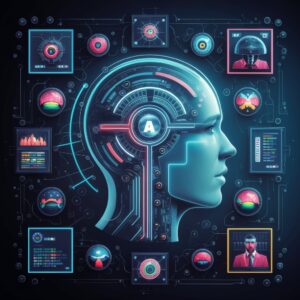 As we navigate the rapidly evolving landscape of business communication in 2024, it is crucial for instructors to stay informed about the latest advancements in artificial intelligence (AI) and its impact on the field. AI has become an integral part of modern business practices, revolutionizing the way companies interact with customers, streamline operations, and make strategic decisions. This article will explore the critical aspects of AI that business communication instructors must understand to effectively prepare their students for success in the contemporary workforce.
As we navigate the rapidly evolving landscape of business communication in 2024, it is crucial for instructors to stay informed about the latest advancements in artificial intelligence (AI) and its impact on the field. AI has become an integral part of modern business practices, revolutionizing the way companies interact with customers, streamline operations, and make strategic decisions. This article will explore the critical aspects of AI that business communication instructors must understand to effectively prepare their students for success in the contemporary workforce.
Natural Language Processing (NLP) and Chatbots
One of the most significant applications of AI in business communication is the use of natural language processing (NLP) and chatbots. NLP enables computers to understand, interpret, and generate human language, allowing for more seamless interactions between humans and machines. [1] The rise of large language models (LLMs) like Bard, LaMDA, GPT-4, and Claude has further enhanced the capabilities of NLP, enabling more sophisticated language understanding and generation. [2] Chatbots, powered by NLP, have become ubiquitous in customer service, providing 24/7 support and personalized experiences. Other applications include AI-powered writing assistants, real-time language translation tools, and voice assistants. Business communication instructors must familiarize themselves with the capabilities and limitations of NLP and chatbots to guide students in effectively leveraging these tools for customer engagement and support.
AI-Assisted Content Creation
AI has also made significant strides in content creation, with advanced algorithms capable of generating written content, images, videos, podcasts, video scripts, and even code. [3] While AI-generated content is not yet perfect, it can greatly assist businesses in creating engaging and personalized marketing materials, social media posts, and email campaigns. However, the growing use of AI in content creation also raises ethical concerns, such as the potential for deepfakes and misinformation. [4] Instructors should explore the potential of AI-assisted content creation tools and teach students how to use them effectively while maintaining a human touch and ethical considerations.
Data Analysis and Predictive Analytics
AI-powered data analysis and predictive analytics have become essential for businesses to make informed decisions and stay competitive. By analyzing vast amounts of data, AI algorithms can identify patterns, predict customer behavior, and optimize business strategies. [5] Advanced techniques like machine learning and deep learning are increasingly used to analyze complex data sets and generate more accurate predictions. Businesses are leveraging AI for customer segmentation, personalized marketing, and risk management. [6] Business communication instructors should emphasize the importance of data-driven decision-making and teach students how to interpret and communicate insights derived from AI-powered analytics to key stakeholders.
Ethical Considerations and Bias Mitigation
As AI becomes more prevalent in business communication, it is crucial to address the ethical implications and potential biases associated with these technologies. AI algorithms can perpetuate existing biases if not properly designed and trained, leading to discriminatory outcomes. [7] Ongoing debates regarding AI bias, explainability, and transparency in decision-making processes highlight the need for responsible AI development and deployment. [8] Organizations and governments are developing ethical frameworks and regulations to address these challenges. [9] Instructors must educate students on the importance of fairness, transparency, and accountability in AI-powered communication systems. They should also emphasize the need for diverse and inclusive teams to mitigate bias and ensure that AI technologies are developed and deployed responsibly.
Adapting to Changing Skill Requirements
The integration of AI in business communication is transforming the skills required for success in the field. While technical skills such as data analysis and programming are becoming increasingly valuable, soft skills like emotional intelligence, critical thinking, and adaptability remain essential. [10] New job roles, such as AI trainers, explainability specialists, and prompt engineers, are emerging as a result of AI adoption. [11] Instructors must adapt their curricula to strike a balance between teaching AI-related skills and nurturing the human qualities that complement and enhance the effectiveness of AI in business communication. Continuous learning and upskilling are crucial for both students and professionals to stay competitive in the AI-driven job market. [12]
Impact on Specific Business Communication Areas
AI is transforming various aspects of business communication, including public relations, marketing, advertising, and internal communication. For example, AI-powered sentiment analysis tools can help PR professionals monitor brand reputation and respond to crises more effectively. [13] In marketing and advertising, AI enables personalized content delivery, targeted ad campaigns, and real-time optimization based on user behavior. [14] AI-powered tools are also facilitating remote work and virtual collaboration, enhancing accessibility and inclusivity in business communication. [15]
Business communication instructors in 2024 must stay at the forefront of AI advancements to adequately prepare their students for the challenges and opportunities of the modern workforce. By understanding the applications of NLP, chatbots, AI-assisted content creation, data analysis, and predictive analytics, instructors can empower students to leverage these technologies effectively. Moreover, by emphasizing ethical considerations, bias mitigation, and the importance of adaptability, instructors can help shape a future where AI and human communication professionals work together harmoniously to drive business success.
References:
[1] Hirschberg, Julia, and Christopher D. Manning. "Advances in Natural Language Processing." Science 349, no. 6245 (2015): 261-266.
[2] Bommasani, Rishi, Drew A. Hudson, Ehsan Adeli, Russ Altman, Simran Arora, Sydney von Arx, Michael S. Bernstein et al. "On the opportunities and risks of foundation models." arXiv preprint arXiv:2108.07258 (2021).
[3] Jiang, Jing, Zixuan Chen, Fei Fang, and Meng Jiang. "A Survey on Artificial Intelligence for Content Creation." ACM Computing Surveys (CSUR) 55, no. 5 (2022): 1-36.
[4] Nguyen, Thanh Thi, Cuong M. Nguyen, Dung Tien Nguyen, Duc Thanh Nguyen, and Saeid Nahavandi. "Deep learning for deepfakes creation and detection: A survey." Computer Vision and Image Understanding 223 (2022): 103525.
[5] Agrawal, Ajay, Joshua S. Gans, and Avi Goldfarb. "Exploring the impact of artificial intelligence: Prediction versus judgment." Information Economics and Policy 47 (2019): 1-6.
[6] Duan, Yanqing, John S. Edwards, and Yogesh K. Dwivedi. "Artificial intelligence for decision making in the era of Big Data–evolution, challenges and research agenda." International Journal of Information Management 48 (2019): 63-71.
[7] Mehrabi, Ninareh, Fred Morstatter, Nripsuta Saxena, Kristina Lerman, and Aram Galstyan. "A survey on bias and fairness in machine learning." ACM Computing Surveys (CSUR) 54, no. 6 (2021): 1-35.
[8] Floridi, Luciano, Josh Cowls, Monica Beltrametti, Raja Chatila, Patrice Chazerand, Virginia Dignum, Christoph Luetge et al. "AI4People—An ethical framework for a good AI society: Opportunities, risks, principles, and recommendations." Minds and Machines 28, no. 4 (2018): 689-707.
[9] Jobin, Anna, Marcello Ienca, and Effy Vayena. "The global landscape of AI ethics guidelines." Nature Machine Intelligence 1, no. 9 (2019): 389-399.
[10] Rai, Arun, Panos Constantinides, and Saonee Sarker. "Next-generation digital platforms: Toward human–AI hybrids." MIS Quarterly 43, no. 1 (2019): iii-ix.
[11] Wilson, H. James, and Paul R. Daugherty. "Collaborative intelligence: humans and AI are joining forces." Harvard Business Review 96, no. 4 (2018): 114-123.
[12] Wang, Zheng, and Jiahui Lv. "Research on the Cultivation of College Students' Artificial Intelligence Literacy." Frontiers in Psychology (2022): 1007-1015.
[13] Kietzmann, Jan, Jeannette Paschen, and Emily Treen. "Artificial intelligence in advertising: How marketers can leverage artificial intelligence along the consumer journey." Journal of Advertising Research 58, no. 3 (2018): 263-267.
[14] Davenport, Thomas, Abhijit Guha, Dhruv Grewal, and Timna Bressgott. "How artificial intelligence will change the future of marketing." Journal of the Academy of Marketing Science 48, no. 1 (2020): 24-42.
[15] Dwivedi, Yogesh K., Laurie Hughes, Elvira Ismagilova, Gert Aarts, Crispin Coombs, Tom Crick, Yanqing Duan et al. "Artificial Intelligence (AI): Multidisciplinary perspectives on emerging challenges, opportunities, and agenda for research, practice and policy." International Journal of Information Management 57 (2021): 101994.
 Excellence in Business Communication
Excellence in Business Communication
Keeping Students on the Leading Edge with Intelligent Communication Technology
The digital transformation sweeping through business is creating a host of new communication tools and techniques that students will encounter during their job searches and in the workplace. A new four-page, magazine-style feature, “Empowering Communicators with Intelligent Communication Technology,” shows 15 applications of artificial intelligence and smart technology. New highlight boxes take a close look at innovations ranging from augmented writing tools to résumé bots.
Highlight boxes take a close look at these innovations:
• Taskbots and virtual teammates
• Real-time voice translation
• Automated storytelling
• Augmented writing tools
• Chatbots
• Text mining
• Résumé bots
• AI-assisted recruiting and interviewing
• Blind auditions



